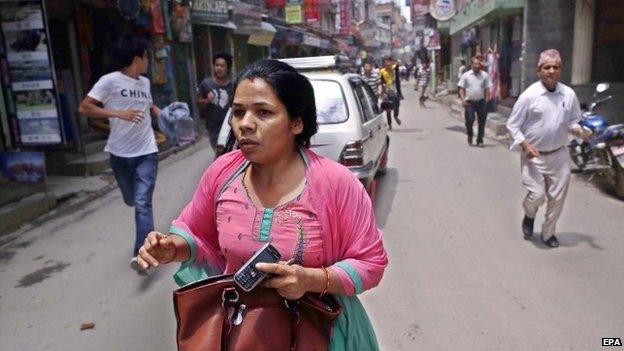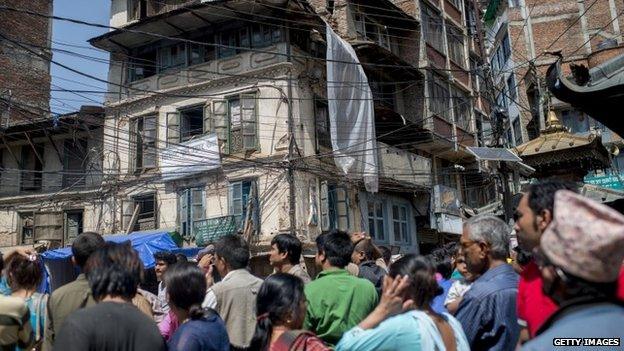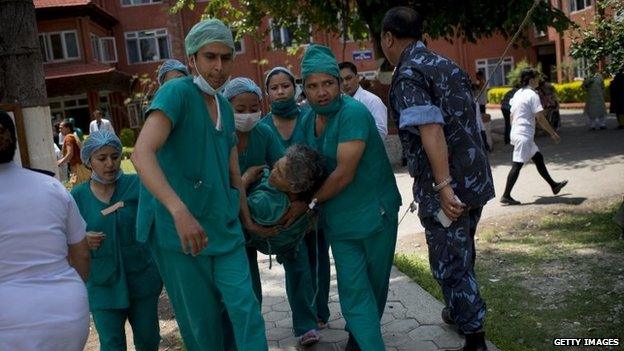Nepal earthquake: Eyewitness accounts
- Published

A second earthquake in Nepal sent people running into the streets
A second major earthquake has struck Nepal just a fortnight after the first, causing tremors as far away as Delhi and sending people running into streets and open areas. We spoke to some of those who felt the ground shake.
Steve Collins, Kathmandu
Steve Collins has lived in Kathmandu for three years. He works for DEC aid agency Tearfund and was at the agency's offices when the earthquake struck.
"Everything suddenly started shaking. It wasn't too severe at first and we all managed to get out of the building, then when we were in the yard outside everything started shaking very strongly and we were all bending down on the ground to stop from falling over, and keeping as far away from the walls as possible.
"I cycled to find my wife and children and there were trees down in the road and some walls, but it's difficult to tell because lots of walls are already down. What was really noticeable was everyone was out in the street and everyone was clearly very shaken. There is a lot of fear and nervousness on the street.

People stood out in the street in Kathmandu to avoid possible collapsing buildings
"The earthquake felt like it carried on for a long while and even when it died down the earth was shaking under our feet, like standing in a boat. It probably lasted about a minute, and there were quite a lot of aftershocks.
"We're all outside at the moment. It's very difficult to know what to do. This has definitely added to the sense of fear and uncertainty."
James Lane, Delhi
James Lane works for children's charity Kid Powered Media in the Indian capital. He was teaching a class of teenagers when the building started to shake.
"We were up on the top floor of a five-storey building and we felt the building start to vibrate. It felt very similar to the previous earthquake. We followed our evacuation policy and got everyone out on the street. The whole thing lasted about a minute, and we didn't feel any aftershocks.
"It was quite mild here but that's the scary thing, in a way. It's a gentle shaking but you realise that somewhere it's very bad for a lot of people. We know that when we feel it like that, it's very bad in Nepal. The kids loved it though."
Yuvraj Agrawal, Dhulikhel
Yuvraj Agrawal is an orthopaedic surgeon from Sheffield volunteering at a hospital in Dhulikhel near Kathmandu.
"I was operating on a lady whose foot was injured in the 25 April earthquake when all it started shaking. Instruments started to drop off the table... The patient, 23, lay under spinal anaesthetic, unable to move from her legs down. She remained calm without moving any muscle.
"She said: 'I'm thinking of my parents who survived the previous earthquake and are now living in a tent in Sindhupalchowk'. I couldn't leave my patient, so I stayed with her.

Medics carry an injured person at Kathmandu's police hospital.
"We've been trying not to react to the multiple aftershocks since then. The hospital is very busy, we've had lots of patients come in but no lost lives. We have suspended planned operations and have five orthopaedic theatres running back to back. Since 25 April, things had slowly been getting back to normal, but this afternoon it has been non-stop."
Sarah Hunt, Kathmandu
Sarah Hunt is a blogger in Nepal to hike the Annapurna Circuit trek.
"I was chatting inside our hostel on the first floor in Thamel, Kathmandu's central tourist district, when the beds around us began shaking. We have already had many aftershocks, so we initially assumed it was one of these, but the intensity kept building.
"I could hear yelling and screams from outside. We bolted out of the room, running down the stairs, which were moving underneath us. We ran into a courtyard outside the hotel, looking above for signs of movement. The ground below felt like it was melting, or rippling like a swimming pool. I dived under a table outside with five others. Everyone was making eye contact and some were screaming.
"Someone called that it wasn't safe so we ran to a wider space. There were high buildings all around us so we kept looking upwards, waiting to see if there was any debris coming down. Everyone was huddling together, some staring numbly, others trying to call relatives.
"I think I just stood there, in a sort of mild shock for a few minutes. My heart was racing and I kept feeling the ground below me. I didn't see any buildings collapse, but we could hear the ambulances and people shouting in the distance."
Yogita Limaye, Baluwa (20km or 12 miles from previous earthquake epicentre)
Yogita Limaye works for BBC News.
"I was in a valley surrounded by tall mountains when the ground started to shake. It felt like it went on for a very long time. Dust and stones started falling off the mountains nearby. All of us on the team and from the relief mission we've been accompanying began to look at each other. 'It's happening again, it's happening again' was a cry I heard.
"At a village nearby, people have already been living under tarpaulin sheets. Pampa Pariar, a 40-year-old woman from a tribal community whose home was destroyed in the earthquake on 25 April, told me she and pretty much everyone from the village ran out when they felt the tremors today."
Yogita Limaye in Baluwa, west of Kathmandu: "I could see dust flying off, stones coming down"
Olivia Lang, Kathmandu
Olivia Lang works for BBC News.
"I was in my hotel room and the floor started to shake. We've had a lot of aftershocks so it took me a few seconds to realise it was serious. I left everything and just ran out of the hotel. Everyone was running as fast as possible.
"There is a building next to my hotel that was damaged in the previous earthquake and had construction workers working high up on it. There was a lot of fear that it would fall over and people were shouting for them to come down off the building.
"Nepalis were calling their families in other parts of Kathmandu and in rural districts to check they were OK. There was lots of panic, the tremor lasted for quite a while.
"There is a rescue team from Los Angeles here that was supposed to leave today but they have been deployed to assess the area.
"There happened to be a structural engineer who assessed our hotel and said it was safe to go back in, but then there was an aftershock."
Bal Sandhu, Kathmandu
Bal Sandhu is the general secretary of aid agency Khalsa Aid. She was in Kathmandu helping with the relief effort for the previous earthquake when everything began to shake again.
"The ground was like a wave when the second earthquake hit, it was so difficult to run because it was shaking so much. The streets stopped and people were fleeing to nearby open spaces.
"At first everyone believed it to be a [small] tremor but soon people realised this was very different. Families were fleeing their already fragile homes to nearby open spaces.
"The people of Nepal had just started to try and rebuild their lives after the devastating impact of the first earthquake. The second quake has compounded the destruction and increased the need for aid greatly.
"Our relief team are all safe and accounted for and will ramp up and continue our relief operations for the people of Nepal."